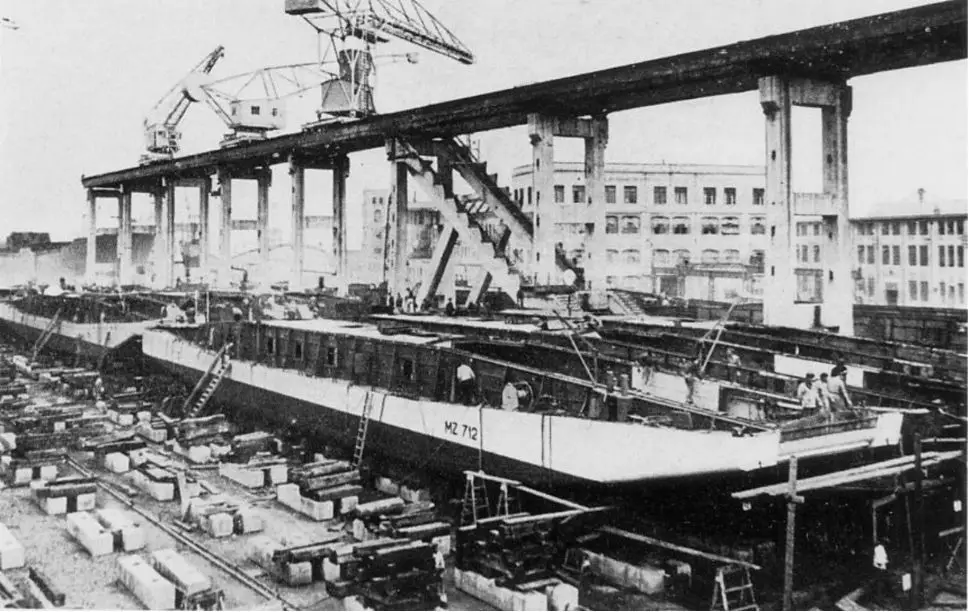
In January 1942, when plans for the invasion of Malta (Operation C3) were beginning to take shape, the Italian Navy completely lacked ships and amphibious vehicles suitable for landing vehicles and armoured units on the beaches.
In order to save time, it was decided to adopt and produce an already existing German design, the landing craft known as MFP (Marine Faehr Prahm)-A. The shipyards of Palermo (Sicily) had already assembled a series of 15 MFP-A on behalf of the Kriegsmarine, thus the Italian authorities asked the Germans for the complete projects and additional components to assemble. After the Germans met these requests, small design changes were made, thus originating the Italian variant which was labelled MZ-A, commonly called “Motozzattere”.
Between MZ-A and MFP-A, the differences were limited to the engine system and armament. The Italian version mounted three, less powerful (150hp vs 390hp) diesel engines while the armament (lighter than the German counterparts) consisted of a 76mm and a 20mm gun, both for AA purposes.
The units, 47 meters long and 6.5 meters wide, displaced 174 tonnes and had a load capacity of 65 tonnes. The engine allowed a speed of 10 knots and a range of 1400 nautical miles. The crew consisted of 13 men, including officers.
The construction order was approved on the 13th of January 1942 for the first series of 50 motorboats (initially called “Bette M.Z.”), together with 100 much smaller landing boats (the M.L.), suitable for the transport and landing of a contingent of 25 soldiers.
The first series of MZs was then expanded to 65 units, numbered from MZ 701 to 765. The prime contractor was the CRDA shipyards of Monfalcone, responsible for the construction of 31 MZ-A.

Figure 1 Motozzattere under construction in Monfalcone
The first deliveries began in May 1942 and should have been completed by July, at the time of the scheduled Operation “C3”. However, Rommel’s dashing advance into Egypt induced the Axis powers to concentrate all available means in the North African sector, including all the Motozzattere and the personnel who were training for the invasion of Malta, like the paratroopers of the Folgore division.
The MZ-A were used to land tanks and supplies on the beaches of Marsa Matruh, an advanced supply base close to the Axis lines. These supplies would have been otherwise transported by land with greater time and difficulty.
At the end of July, the MZ began an incessant shuttle between Tobruk and Marsa Matruh, along a route 330 miles long, transporting tanks and all the material necessary for the operations. Although the modest size and low profile did not make them easy targets, losses, due both to air attacks and drifting mines, did not take long to occur. During the first month of continuous activity, 15 vessels out of 65 were lost.
In mid-September 1942, when the British decided to launch a commando raid against Tobruk, a few MZ-A were engaged in combat.
These units, moored in the waters of the port of Tobruk, were the first to thwart the enemy landing attempt during the night by firing their cannons at zero elevation. At dawn, they headed against the retreating British forces towards the open sea.
In this period, given the good results of the use of these vessels and also to replace the losses suffered, a second series of 40 units was ordered from the Italian shipyards. Following the British offensive in October 1942, the MZ were used to evacuate Navy materials and personnel from Marsa Matruh for a total of 1700 tons of materials and 2100 men and, when Libya was abandoned, the available MZ transported men and vehicles to Tunisia.

Figure 2 Motozzattere at Marsa Matruh
In August 1943, when the Axis forces evacuated Sicily, the surviving MZ, (around 50 units) allowed the transfer of around 62,000 men of the Italian contingent to Calabria.
As evidence of this activity, carried out under continuous enemy attacks, 13 units were lost during such operations, and their hulls were abandoned on the shores of the Strait of Messina.
Essentially all the remaining MZ were captured by the Germans after the armistice of the 8th of September 1943, when Italy signed the armistice with the Allies. Interesting to notice, for the Germans the MZs were an integral part of the numbering of their MFPs. In fact, the numbers from 700 to 800 of the MFP sequence were left available for the Italian MZs. When they captured the Italian units, they were simply renamed F-XXX maintaining the original number.
One MZ, the 737, which survived the war and later served in the post war Italian navy, is still existing today as a museum ship in Venice.
Sources
Giorgio Giorgerini, La Guerra Italiana sul mare: la marina tra vittoria e sconfitta 1940–1943, Edizione Mondadori (2001).
Erminio Bagnasco, In guerra sul mare, Vol. 3-4, (2012)
Marina Militare Italiana, Motozzattere da MZ 701 a MZ 731
Marina Militare Italiana, Le Motozzattere Italiane